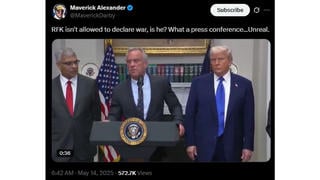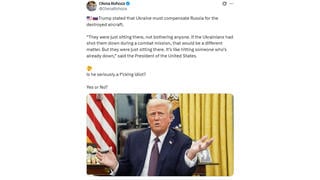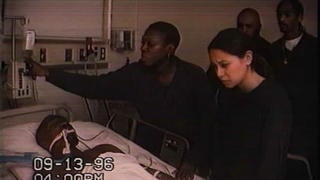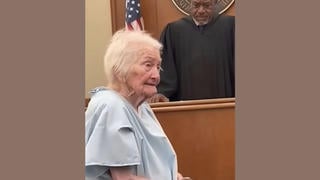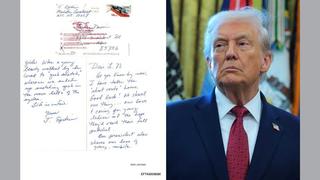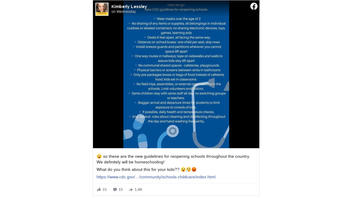
Did the CDC issue guidelines ordering schools to make children over the age of 2 wear masks, forbidding children from sharing toys and requiring physical barriers in bathrooms -- all for schools to reopen amid the COVID-19 outbreak? No, that is not true. A claim labeled by one Facebook commentator as an "Orwellian developmental nightmare" does not accurately reflect the actual recommendations from the CDC, which are not mandatory federal rules.
The Centers for Disease Control and Prevention offered updated considerations for ways that schools can "help protect students, teachers, administrators, and staff and slow the spread of COVID-19," on May 19, 2020, and stated, "Schools may consider implementing several strategies to maintain healthy environments."
The "Orwellian developmental nightmare" claim appeared in a post (archived here) where it was published on Facebook on May 20, 2020. It opened:
So these are the new guidelines for reopening schools throughout the country. We definitely will be homeschooling!
This is what the post looked like on Facebook at the time of writing:
The blue meme going viral on Facebook with CDC "Guidlines" (spelled incorrectly) are not the actual guidelines from the CDC issued on May 19, 2020.
The Centers For Disease Control and Prevention has issued "Considerations for Schools," as states around the country prepare to open up after being shutdown to prevent the spread of the novel coronavirus.
The CDC offered no absolutes and noted, "Schools can determine, in collaboration with state and local health officials to the extent possible, whether and how to implement these considerations while adjusting to meet the unique needs and circumstances of the local community. Implementation should be guided by what is feasible, practical, acceptable, and tailored to the needs of each community."
There were separate guidelines for K-12 schools from the CDC found here and for child care centers found here.
The claims in the meme are not accurate descriptions of the CDC guidelines, which the agency advised were not a mandate but suggestions to help spread prevent the spread of coronavirus when schools returned to in-person teaching:
Implementation should be guided by what is feasible, practical, acceptable, and tailored to the needs of each community. School-based health facilities may refer to CDC's Guidance for U.S. Healthcare Facilities and may find it helpful to reference the Ten Ways Healthcare Systems Can Operate Effectively During the COVID-19 Pandemic. These considerations are meant to supplement--not replace--any state, local, territorial, or tribal health and safety laws, rules, and regulations with which schools must comply.
The meme claims schools will require children to "Wear masks over the age of 2."
This is not what the CDC recommends and notes that "cloth face covering" is different than a surgical mask.
The CDC advises the use of "cloth face covering," recognizing the challenges for students (especially younger students) to wear in all-day settings such as school:
Cloth Face Coverings
• Teach and reinforce use of cloth face coverings. Face coverings may be challenging for students (especially younger students) to wear in all-day settings such as school. Face coverings should be worn by staff and students (particularly older students) as feasible, and are most essential in times when physical distancing is difficult.
o Note: Cloth face coverings should not be placed on:
Children younger than 2 years old
Anyone who has trouble breathing or is unconscious
Anyone who is incapacitated or otherwise unable to remove the cloth face covering without assistance
• Cloth face coverings are meant to protect other people in case the wearer is unknowingly infected but does not have symptoms. Cloth face coverings are not surgical masks, respirators, or other medical personal protective equipment.
From the meme:
No sharing of any items or supplies, all belongings in individual cubbies or labeled containers; no sharing electronic devices, toys, games, learning aids
The CDC does not tell schools there should be "No" sharing. The agency recommends on its website that K-12 schools should "avoid" sharing:
Shared Objects
• Discourage sharing of items that are difficult to clean or disinfect.
• Keep each child's belongings separated from others' and in individually labeled containers, cubbies, or areas.
• Ensure adequate supplies to minimize sharing of high touch materials to the extent possible (e.g., assigning each student their own art supplies, equipment) or limit use of supplies and equipment by one group of children at a time and clean and disinfect between use.
• Avoid sharing electronic devices, toys, books, and other games or learning aids.
For child care facilities, the CDC offers guidelines, found here, about how to deal with younger children.
The guidelines recommend staff "Routinely clean, sanitize, and disinfect surfaces and objects that are frequently touched, especially toys and games."
The CDC warns, "Toys that cannot be cleaned and sanitized should not be used," and also advises: "Do not share toys with other groups of infants or toddlers, unless they are washed and sanitized before being moved from one group to the other."
From the meme:
Physical barriers or screens between sinks in bathrooms
Again, the CDC does not mandate barriers be installed.
The agency recommends ways that protections for teachers, students and staff can be implemented to slow the spread of COVID-19.
The CDC recommends schools "add" the physical barriers but does not say they are required.
"Add physical barriers, such as plastic flexible screens, between bathroom sinks especially when they cannot be at least 6 feet apart.
For child care centers the document does not mandate this. In fact, the only barriers mentioned in the document suggest schools "Consider installing physical barriers, such as sneeze guards and partitions at cash registers, or other food pickup areas where maintaining physical distance of six feet is difficult."



